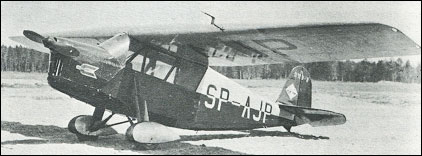|
| The prototype of a much refined version of the earlier R.W.D. two-seaters was flown on 7 August 1931, and in appearance this was a conventional high-wing monoplane typical of the period. Successful testing of the R.W.D.5 prototype led to the construction of 20 production aircraft by D.W.L. in two batches, these being used extensively in sporting/touring activities and enjoying a good share of competition success. However, the most outstanding performance of the R.W.D.5 was that achieved by SP-AJU converted as the R.W.D.5bis for an attempted nonstop flight over the South Atlantic. With a reduced-span reinforced wing, increased fuel capacity and powered by a 97kW de Havilland Gipsy Major engine, it was flown successfully by Captain Stanislaw Skarzyhski to achieve a remarkable nonstop crossing from St Louis-de-Senegal to Maceio, Brazil during 7/8 May 1933. It remains, to this day, the lightest aircraft to complete a nonstop flight across the South Atlantic, an achievement that brought great respect for the capability of the R.W.D. design team.
| ENGINE | 1 x Hermes IIB inline piston engine, 86kW |
| WEIGHTS |
| Take-off weight | 760 kg | 1676 lb |
| Empty weight | 445 kg | 981 lb |
| DIMENSIONS |
| Wingspan | 10.5 m | 34 ft 5 in |
| Length | 7.2 m | 24 ft 7 in |
| Height | 2.7 m | 9 ft 10 in |
| Wing area | 15.0 m2 | 161.46 sq ft |
| PERFORMANCE |
| Max. speed | 200 km/h | 124 mph |
| Ceiling | 4700 m | 15400 ft |
| Range | 1080 km | 671 miles |
| Marcin, 05.09.2010 11:54 This is the first aircraft that flown across the Atlantic Ocean (but from Africa to Brazil). Apparently, it was also the lightest one... reply |
|
Do you have any comments?
|
| 
All the World's Rotorcraft |





